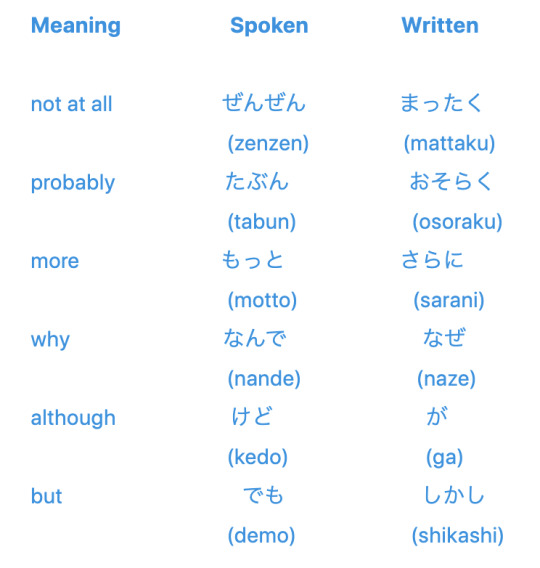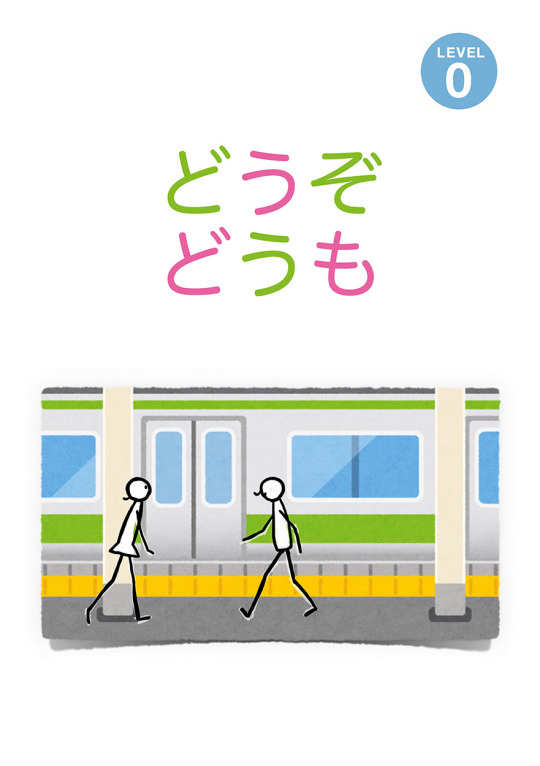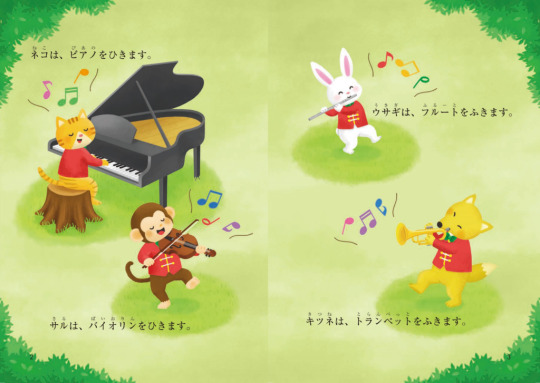#japanese for beginners
Text
IRL Japanese 2: Things the kids I teach say all the time
If you're planning to work as an ESL teacher in Japan working with kids, this vocab is gonna be super useful for you! You'll pick up a lot as you go along, but it's good to have an overview from the start.
できた = done, finished (whenever they finish an exercise I've set them. The older kids will use the ます-form, but kids under like age 8 will use this one)
かえる?= is it time to go home? (lit: go home?)
わかった = got it (again, the older kids will use the ます-form)
わからない / わかんない = I don't get it (idk if わかんない is just dialect or if it's common overall, but I hear it more than わからない. Usually from the kids who don't wanna be there and are making zero effort)
ちがう = wrong / different (when they give an answer but realise it's not correct. It's basically like "wait, no")
ばか = idiot (sometimes boys say this to their friends)
全部?(ぜんぶ)= everything?! (asked in disbelief when I ask them to write more than one word)
やめろ = stop it! (used with friends when they're teasing each other)
いたいよ = that actually hurts, you know! (used with friends when they're rough-housing)
よし (more like 'yoshhh') = right then (filler word indicating the start of an activity or a change of activity)
水筒(すいとう)= water bottle (most kids bring one to class and frequently forget to take them with them when they go home)
忘れた(わすれた)= I forgot (usually in reference to the text book they left at home)
トイレに行きたい = I want to go to the bathroom
先生、大好き!(せんせい、だいすき!)= I love you, Sensei!
Other useful classroom/school vocabulary:
サイコロ = dice
トランプ = playing cards
ごろごろ = onomatopeia for the sound for rolling (I found the kids got confused if I just mimed rolling a dice/ball and said "roll!" but if I did the gesture and said "gorogoro", they understood)
ビリビリ = onomatopeia for ripping (useful for when you have tear-apart crafts in class)
ケシケシ = onomatopeia for erasing something (useful when you try to explain to a kid they spelled something wrong. Because it's easier to just say "A kesh-kesh, E" than "Not A, E. Okay great you wrote E, but A needs to go. No no no not the whole word, just A. Oh my God. Okay. Let me write it and you copy.")
ちょっと = a little, soon, wait a little (useful if the kids are getting a bit antsy and ready to go home a bit too early/don't want to wait their turn. Don't use it with parents though!)
がんばれ = do your best / you can do it!
あぶない!= dangerous / look out! (useful if a kid unexpectedly runs in front of me while I'm carrying a table)
せえの!= Altogether now! (When I need the kids to repeat something after me)
だめだよ = Don't do that (for when the kids repeatedly do something I've asked them not to do)
少々お待ちください(しょうしょう おまち ください)= polite form of "please wait a moment". Useful if you have a parent talking to you and you need to go get something (e.g. a communication sheet for them to point at so you know what they're trying to say)
授業参観 (じゅぎょうさんかん) = parent observation (PO). A couple of times a year, parents are invited into the classroom to watch the lesson (absolutely not a thing in the UK, not sure about other countries). The past two months I've had POs at my various schools, and so the parents come to the door and ask me if it's PO week. I don't understand most of the question, but I can pick out this one word and a question particle and figure out what they're asking.
It's also obviously a good idea to learn vocabulary related to stationery (eraser, pencil, crayon, pen, notebook, textbook, pencil case etc) because kids forget/lose their stuff all the time and will inevitably ask you if they can borrow something.
505 notes
·
View notes
Text
Learning Japanese guideline for beginners
Are you ready to dive into the wonderful world of Japanese? Awesome! Buckle up, because we're about to embark on an exciting journey together.
On this website, we will show you how to learn Japanese from zero!
47 notes
·
View notes
Text
にくい - Difficult to, Hard to
Verb in noun form[ます]+ にくい
Polite: Verb in noun form[ます]+ にくい + です
Like 易い (やすい), にくい is an い-Adjective that is regularly attached to the ます stem of verbs, communicating the difficulty of performing the verb that precedes it. In other words, the verb, aka whatever is difficult to do, will always come before にくい.
The nuance of にくい is that a task is difficult to do because of the required skill level or similar factors.
私には英語の「Literally」という単語がとても言いにくい。For me, the English word ‘literally’ is very hard to say. (Hard due to the individual's skill level)
アフリカには行きにくいです。It is hard to go to Africa.
This is different from づらい, which focuses more on a task that is difficult due to being unbearable/hard to endure for some other reason (such as emotional). For example:
お前には本当に言いづらいけど、お前のギターを壊した。ごめん。This is very difficult for me to say to you, but I broke your guitar. I'm sorry. (Hard because the speaker knows that telling the listener will cause a negative response)
#japanese#learn japanese#japanese studyblr#how to learn japanese#studyblr#learning japanese#hiragana#japanese beginner#japanese langblr#japanese for beginners#N4#n4 grammar#japanese n4#japanese lesson#japanese grammar#learn how to speak japanese
84 notes
·
View notes
Text
謙譲語 - Humble Keigo
敬語 (けいご・keigo) is respectful speech in Japanese. 敬語 is based in the social hierarchy that has carried over into modern Japanese society from ancient times. There are three forms of 敬語 - teineigo, sonkeigo, and kenjougo.
謙譲語 (けんじょうご・kenjougo) is humble Japanese. This style is used when referring to yourself, or to someone in your inner circle - like your family, your colleagues, etc. This style should be used when you are speaking to someone of higher social rank when describing your actions or the actions of someone in your inner circle. You must never use this style to refer to someone who is not in your inner circle or to refer to the person you are talking to.
Regular Kenjougo Verb Forms
To create the humble form of most verbs, add the prefix お to the stem form of the verb and add する to the end.
Polite Form → Humble Form
Verb-stem + ます → お + Verb-stem + します
待ちます → お待ちします (おまちします) to wait
教えます → お教えします (おおしえします) to teach
書きます → お書きします (おかきします) to write
Irregular Kenjougo Verb Forms
Plain Form → Humble Form
行く (いく)・来る (くる) → 参ります (まいります) to go/to come
いる → おります to be
食べる (たべる)・飲む (のむ) → いただきます to eat/to drink
言う (いう) → [意見を]申し上げます ([いけんを]もうしあげます) to say (one's opinion)
言う (いう) → [名前と]申します ([なまえと]もうします) to be called (name)
見る (みる) → 拝見します (はいけんします) to see
する → いたします to do
知っている (しっている) → [今日会議があることを]存じております ([きょうかいぎがあることを]ぞんじております) to know (something)
知っている (しっている) → [社長を]知っております ([しゃちょうを]しっております) to know (someone)
あげる → さしあげます to give
もらいます → いただきます to receive
思う (おもう) → 存じる (ぞんじる) to think/to feel
聞く (きく) → 伺う (うかがう) to ask/to listen
会う (あう) → お目にかかります (おめにかかります) to meet
読む (よむ) → 拝読します (はいどくします) to read
~ている → ~ております Verb -ing (ongoing action, state, repetition)
Other Humble Forms
です → でございます copula
人 (ひと) → 者 (もの) person
丁重語 - Courteous Language
In addition to 謙譲語 there is also 丁重語 (ていちょうご・teichougo), or courteous language, which is humble language in which an action or object is not directed toward the listener or a third party, but when you are speaking to someone with whom you wish to be very polite.
Because these phrases are associated with being humble, they are listed above but I am also grouping them here.
おります to be
参ります (まいります) to go/to come
いたします to do
いただきます to receive/to eat/to drink
申します (もうします) to say, to be called
存じております (ぞんじております) to know
Example Sentences
I am Sakura.
Normal: さくらです。
謙譲語: さくらと申します。
I read this book.
Normal: この本を読みました。
謙譲語: この本を拝読しました。
The train is arriving.
Normal: 電車が来ます。
謙譲語: 電車が参ります。
See also: Basic Keigo, Polite Keigo, Honorific Keigo
#日本語#japanese#japanese language#japanese langblr#langblr#studyblr#japanese studies#敬語#謙譲語#keigo#polite japanese#honorific japanese#humble japanese#beginning japanese#japanese for beginners#intermediate japanese#tokidokitokyo#tdtstudy#敬語④
143 notes
·
View notes
Text
youtube
1 note
·
View note
Text
日本語で大切なこと
The Important Points in The Japanese Language

1. 単語(たんご)Vocabulary
日本語の数に関する単語には、使う場面によっていろいろな発音のバリエーションがあります。今回は、いちばん一般的なパターンをご紹介します。
The Japanese vocabularies regarding numbers have many versions of pronunciation depending on the use of the number. There are the most common variations of numbers below.

時間(Hours)"number+ji"【4/7/9】
時間について話すとき発音が変わる数字がありますが、他の数字の発音は変わりません。
When you are talking about hours, the pronunciations of those numbers above are changed. Other numbers are pronounced in the same way.
日付(Date)
日付を表す数字は、日本の古い発音が元になっているようです。特に1日〜10日は一般的な発音と大きくちがいます。
It seems the pronunciations of the date in a month are based on the very old Japanese pronunciation of numbers. Especially 1st to 10th have different pronunciation from the general ones.
2. 言葉のスタイル(Style of words)
話し言葉と書き言葉
Spoken Japanese and Written Japanese
日本語には、文書に使われるだけで会話では使わない言葉がいくつかあります。ふつうの会話でそういった言葉を使うと、少しフォーマルで礼儀正しく聞こえます。よく使われる書き言葉と話し言葉をご紹介します。
In the Japanese language, some words are used only for writing but not for speaking. If you use those words in the general conversation, some of them sound a little more formal and nice. There are common words both in written and spoken Japanese below.

話し言葉は、友達や家族間のEメールや、SNS、キャッチコピーなどの文書にも使われます。ビジネスメールや報告書などフォーマルな文書では、書き言葉を使う必要があります。
We often use spoken Japanese for writing as well. Spoken Japanese is used in an E-mail between friends or family, SNS, a catchy phrase, and so on. We have to use written Japanese in more formal forms such as business E-mails and reports.
ありがとうございました!Thank you!
次回は、助詞「に」と「を」の使い方をご紹介します。
最後まで読んでいただき、ありがとうございました!
In the next article, I'll introduce the use of the Japanese particle "に(ni)" and "を(o)".
Thank you for visiting Akatsuki Note!
0 notes
Text
If you wish to learn Japanese, read this blog post first. Here we discuss the benefits of learning Japanese, a brief description of its characteristics, and how you can learn it online. We also discuss some study tips below.
#learn japanese#japanese language#japanese writing#to learn japanese#learn japanese online#learn japanese language#japanese language course#learn to speak japanese#japanese course#study japanese#japanese online course#japanese for beginners
0 notes
Text
Japanese Reading Resources for Absolute Beginners
A question I encounter often is "How much Japanese should I study before I can begin reading in Japanese?"
From my experience as a learner and reader myself and from managing a Japanese book club for other learners I can honestly say that you can start way earlier than you probably think!
There are many resources that only require knowing hiragana. Those texts usually teach vocabulary through pictures and only use basic grammar.
Some are even simpler than that: The Japan Foundation's Hiragana Books are great for those, who are still remembering hiragana characters. Every short book introduces only 1-2 new characters, so it's a great reading exercise for those who've just started.

The free graded reader 「どうぞ、どうも」 by the NPO Tagengo Tadoku only uses the words 「どうぞ」 and 「どうも」 to write an entire story. Again, this makes for a great exercise in reading hiragana and understanding context. Another "level 0" recommendation by the same NPO would definitely be 「しろい?くろい?」. This book uses the full range of hiragana characters but the grammar is simple and all used vocabulary is illustrated.


Another site with great resources for absolute beginners is Nihongo Tadoku Dōjō. If you have memorized both hiragana and katakana and know how the particles を and で work you will be able to read this text about stationary (ぶんぼうぐ) and understand everything by looking at the pictures!

The resources linked so far can all be accessed completely free on the linked websites. If you have the money to spare, please also have a look at the box 「��タート」 from the series reberubetsu nihongo tadoku raiburarī published by the NPO Tagengo Tadoku and ASK (affiliate link). This box includes 8 little books in very simple Japanese.

All these texts for absolute beginners will get you started reading in Japanese with very little knowledge of characters and vocabulary.
Reading in Japanese is a skill that requires practice. But once you get used to it, it can be such a valuable tool to reinforce new vocabulary and grammar. So please don't wait until you're "ready" before you start reading - start early at your own level!
#my book reviews#reading in japanese#study japanese#learning japanese#日本語#japanese books#やさしい日本語#free graded readers#free tadoku graded readers#nihongo tadoku dōjō#absolute beginner level#japanese langblr#japanese language#japanese reading comprehension#japanese free reading resources#japanese reading resources
650 notes
·
View notes
Text
Energy Explained in Other Systems
There is a lack of measurable evidence because any person that has worked with energies have had different experiences but were able to understand and manipulate energies according to their own will.
Energy has been used in many ways within culture and religion and have set beliefs depending on the system being practiced.
Next, are some given definitions defining energies within diverse philosophies.
Hindu = Prana
Chinese = Qi /Chi
Japanese =Ki
Greek = Pneuma
Hawaiian = Mana
Tibetan Buddhism = Lung
Hindu Philosophy
A Sanskrit word for "life force" or "vital principle" is often referred to as Prana. It is described as first coming down from the Sun and connecting all elements of the Universe. It has been invoked within the Hindu scriptures of the Vedas and Upanishads.
Prana is the belief of vitality surrounding all living beings. This energy is responsible for all bodily functions. There are five types of pranas, collectively known as the five vāyus.
1. Prāṇa: Beating of the heart and breathing. Prana enters the body through the breath and is sent to every cell through the circulatory system.
2. Apāna: Elimination of waste products from the body through the lungs and excretory systems.
3.Uḍāna: Sound production through the vocal apparatus. It represents the conscious energy required to produce the vocal sounds corresponding to the intent.
4. Samāna: Food digestions, repair or manufacture of new cells and growth, and heat regulations throughout the body.
5. Vyāna: The energy that is needed for the body to have proper circulation, and the functions for the voluntary muscular system in which there is expansion and contraction processes throughout the body.
Chinese Philosophy
The earliest texts in which Qi or Chi is described was in 'Analects of Confucius' where it could mean "breath" and was combined with the Chinese word for blood.
Xue-qi, "blood and breath."
Living beings are born because of an accumulation of qi, and as the beings live out their lives the qi declines eventually resulting in death. This indicates that xue-qi referred to all living things, but it is believed that qi or chi exists within all things tangible.
For example, the wind is the qi or chi to the Earth, and the cosmic concepts of yin and yang are "the greatest of qi"
Yin and Yang which means "bright-dark," and "positive-negative" are the opposing forces needed in order to complement the concept of balance. There are thoughts that this duality symbolizes contradicting energy forces which manifest as light and dark, fire and water, expansion, and contraction. With this said, Chinese medicine states that the balance of negative and positive forms in the body are believed to be essential for overall satisfactory health.
Japanese Mythology
During the sixth and seventh centuries the Chinese word qi (or chi) was written using the same kanji script for their interpretation for energy being "Ki"
However, the meanings are a tad different.
While the Chinese use chi or qi to describe that energy exists in all things, animate and inanimate objects, the Japanese believe it is the creative flow and expressions used within our daily lives, martial arts, and symbolizes aspects of nature, and thusly the spirits. It is the transfer from living, animate beings in to inanimate which can change and manifest into various forms. It is the necessary intentions one wields.
Greek Mythology
Pneuma, "The breath of life" or "vital spirit" is composed of kinetic energies within the vessel, while Ignis is composed of thermal energies. All human beings need both kinetic and thermal energies in order to properly function.
In Greek medicine, pneuma is the form of circulation throughout the body's vital organs. Due to this the role, pneuma plays within the body to sustain consciousness. Some physiological theories suggest that the pneuma mediates between the heart, and the heart is regarded as the seat of the mind, and the brain.
In similar, Stoic philosophy, pneuma is the active and generative principles that are organized between the individual and the cosmos. The highest forms are the Gods, and the human soul. The human soul is believed to be fragments of the gods given life force in order to be born and given a vessel upon the physical plane. This exists within all animate and inanimate objects as energy transfers and changes.
Hawaiian Mythology
Mana, the spiritual energy of power and strength. This energy exists within places and people; however, it is said that mana is both external and internal concepts.
The Hawaiian people believe that individuals can gain mana or lose it depending on one's actions in everything that they do.
In mythology there were two ways to gain mana, and this was either done sexually or through violence.
To sexually gain mana one must invoke the god, Lono, deity of peace and fertility.
To gain mana through violence one must invoke the god Ku, deity of war and politics.
Tibetan Buddhism
Lung means the wind or breath. Exists as a key concept in Vajrayana traditions. Generally, it's concept relates to the understanding of the subtle body, and Three Vajras. Those three are the body, speech, and mind. Lung relates to the subtle flow of energy and the five elements. (Fire, Water, Earth, Space, and Air) Lung is mostly closely connected to the Air Element.
Lung has also been used to describe the winds or prana being used in conjunction with the subtle body during a time of exercise, but also more importantly everyday functions of the body and its own senses. There are five psychic winds which manifest into mahabhuta. These five relate to the lifeforce that animate the body-mind (namarupa) of all sentient beings.
The Five Root or Major Winds
The root winds support an element and is responsible for a function of the human body.
The 'life-supporting wind' (Tib. སྲོག་འཛིན་རླུང་, sok dzin lung; Wyl. srog 'dzin rlung).
Located in the brain, this lung regulates functions such as swallowing, inhalation, and concentration.
The 'upward-moving wind' (Tib. གྱེན་རྒྱུ་རླུང་, gyengyu lung; Wyl. gyen rgyu rlung).
Located in the chest and thorax, this lung regulates, among other things, speech, the body's energy and vitality, memory, mental endeavour and diligence.
The 'all-pervading wind' (Tib. ཁྱབ་བྱེད་རླུང་, khyap ché lung; Wyl. khyab byed rlung). Residing in the heart, this lung controls all the motor activities of the body.
The 'fire-accompanying wind' (Tib. མེ་མཉམ་གནས་རླུང་, me nyam né lung; Wyl. me mnyam gnas rlung). Found in the stomach and abdomen area, the fire-accompanying wind regulates digestion and metabolism.
The 'downward-clearing wind' (Tib. ཐུར་སེལ་རླུང་, thursel lung; Wyl. thur sel rlung). Located in the rectum, bowels and perineal region, this lung's function is to expel faeces, urine, semen, and menstrual blood. It also regulates uterine contractions during labour.
The Five Branch Winds
The five branch winds enable the senses to operate.
The naga wind (Tib.ཀླུའི་རླུང་, lu'i lung; Wyl. klu'i rlung). This lung connects with the eyes and sight.
The tortoise wind (Tib. རུ་སྦལ་གྱི་་རླུང་, rubal gyi lung; Wyl. ru sbal gyi rlung). This wind connects with the heart and the sense of hearing.
The lizard wind (Tib.རྩངས་པའི་རླུང་, tsangpé lung; Wyl. rtsangs pa'i rlung) associated with the nose and the sense of smell.
The devadatta wind (Tib.ལྷས་བྱིན་གྱི་རླུང་, lhéjin gyi lung; Wyl. lhas byin gyi rlung) related to the sense of taste.
The 'king of wealth deities' wind (Tib. ནོར་ལྷ་རྒྱལ་གྱི་རླུང་, nor lha gyal gyi lung; Wyl. nor lha rgyal gyi rlung). This wind connects with the body and the sense of touch.
#energy work#pagan#witch#witch community#pagan witch#witchblr#witchcraft#beginner witch#baby witch#witch tips#energy manipulation#philosophy#theology#greek mythology#hindu mythology#buddhism#hawaii mythology#chinese mythology#japanese mythology#metaphyics#metaphysical#spiritualism#spirituality
331 notes
·
View notes
Text
N5 Grammar Review: Vない
The ない form of the verb is used to mean "not" or "don't". I'm going to make some posts about grammar that uses this form soon, but first I thought it'd be good to go over how exactly we get the ない form.
To make the ない form:
Group 1: change the last 'u' in the dictionary form to 'a', then add ない:
書く(かく)→ 書かない [to write -> not write]
話す(はなす)→ 話さない [to speak -> not speak]
立つ(たつ)→ 立たない [to stand -> not stand]
遊ぶ(あそぶ)→ 遊ばない [to play -> not play]
読む(よむ)→ 読まない [to read -> not read]
知る(しる)→ 知らない [to know -> not know]
Be careful! If the verb ends in う, it becomes わ:
歌う(うたう)→ 歌わない [to sing -> not sing]
買う(かう)→ 買わない [to buy -> not buy]
Group 2: add ない to the stem:
食べる(たべる)→ 食べない [to eat -> not eat]
寝る(ねる)→ 寝ない [to sleep -> not sleep]
見る(みる)→ 見ない [to see -> not see]
教える(おしえる)→ 教えない [to teach -> not teach]
Group 3 of course is a bit different:
する → しない [to do -> not do]
来る(くる)→ こない [to come -> not come]
The ない form is used in casual speech to mean "don't/doesn't do":
Particles in brackets because you can drop them in casual speech.
魚(は)食べない
さかな(は)たべない = I don't eat fish
父(は)雑誌(を)読まない
ちち(は)ざっし(を)よまない = My dad doesn't read magazines
コーヒー(を)全然飲まない
コーヒー(を)ぜんぜん のまない = I don't drink coffee at all
Other than that, the ない form is used a lot as a base for more complex grammar. It's important to get to grips with it early on.
I'm still a beginner myself (I'm only N4 level!) so please let me know if I've made any mistakes!
#japanese langblr#learning japanese#japanese grammar#japanese for beginners#beginner japanese#n5#n5 grammar
99 notes
·
View notes
Text
How long does it take to master Hiragana and Katakana?
As you know, learning Hiragana and Katakana is the first step to learn everything about Japanese language. Depending on your time investment, your goals, the learning duration will be different!
It takes 1-4 weeks to master these Japanese alphabets normally. Let's start learning Hiragana with MochiKana and you'll be able to memorize all characters in just one week!
1 note
·
View note
Text
There is/are
Different from です because it establishes existence and/or possession. Uses particle が because there is emphasis on the fact that it is in existence.
There is room for ambiguity because there isn’t a need for specification on whether the object is plural or singular.
ある・ありますNonliving thing
Xがあります
there is/are X (nonliving)
Example: 本があります I have a book (Lit. There is a book)
—————————
いる・いますLiving thing
Xがいます
there is/are X (living)
Example: 猫がいます I have a cat/there is a cat
Note: plants use ある for some reason, but bacteria/microorganisms actually use いる!
——————————
Location description:
Place に thing が ある
“at <place> there is <thing>” ie. “there’s a student over there”
• It calls for particle に rather than で for the place description. に can specify locations of existence like it specifies times and dates (kind of like on/at/to)
• The place description usually comes at the beginning of sentence.
• The thing description is usually followed by the particle が rather than は (more on that later)
1. There is/are X (が)
あそこにマクドナルドがあります。(There is a McDonalds over there.)
2. You have X
(は is often used for added clarification)
私はテレビがありません。(I don’t have a TV OR I am the one without a TV)
私の先生はこどもがいます。(My sensei has children.)
ロバートさんはおねえさんがいます。(Robert has an older sister.)
#Japanese#Study Japanese#Learn Japanese#Beginner Japanese#Japanese for beginners#Japanese langblr#Japanese studyblr#Hiragana#Katakana#learn to read Japanese#peistudies#pei
112 notes
·
View notes
Text
[Japanese→English] @panmaumau Tweet — Color Coded Translation

————————————————————————
何も知らない生き物の顔
なにもしらないいきもののかお
The face of a living thing that doesn’t know anything.
————————————————————————
Please correct me if I made a mistake
#color coded translation#japanese#japanese vocabulary#study japanese#japanese lesson#easy japanese#beginner Japanese#learning japanese#japanese lingblr#japanese linguistics#learn japanese#japanese langblr#japanese learning#japanese language#japanese vocab
81 notes
·
View notes
Text
尊敬語 - Honorific Keigo
敬語 (けいご・keigo) is respectful speech in Japanese. 敬語 is based in the social hierarchy that has carried over into modern Japanese society from ancient times. There are three forms of 敬語 - teineigo, sonkeigo, and kenjougo.
尊敬語 (そんけいご・sonkeigo) is honorific Japanese. This style is used to show respect to someone of a higher position (a superior, an elder, a customer, etc.) when speaking about them. You must never use this form to refer to yourself. This form is characterized by lengthy polite sentences and common verbs are exchanged for more polite ones or changed into a respectful form.
Regular Sonkeigo Verb Forms
To create the honorific form of most verbs, add the prefix お to the stem form of the verb and add になる to the end.
Polite Form → Honorific Form
Verb-stem + ます → お + Verb-stem + になります
読みます → お読みになります (およみになります) to read
待ちます → お待ちになります (おまちになります) to wait
教えます → お教えになります (おおしえになります) to teach
書きます → お書きになります (おかきになります) to write
思います → お思いになります (おおもいになります) to think
Irregular Sonkeigo Verb Forms
Plain Form → Honorific Form
行く (いく)・来る (くる) → いらっしゃいます/おいでになります to go/to come
いる → いらっしゃいます/おいでになります to be
食べる (たべる)・飲む (のむ) → 召し上がります (めしあがります) to eat/to drink
寝る (ねる) → お休みになります (おやすみになります) to sleep
言う (いう) → 仰る (おっしゃいます) to say
見る (みる) → ご覧になります (ごらんになります) to see
着る (きる) → お召しになります (おめしになります) to wear
する → なさいます to do
知っている (しっている) → ご存知です (ごぞんじです) to know
くれる → くださいます to receive
座る (すわる) → お掛けになります (おかけになります) to sit/to be seated
Other Honorific Forms
です → でいらっしゃる copula
家 (いえ) → 御宅 (おたく) home
どう → いかが how
Example Sentences
Excuse me, is Professor Tanaka here?
Normal: すみません、田中先生はいますか。
尊敬語: すみません、田中先生はいらっしゃいますか。
How was the interview?
Normal: 面接はどうでしたか。
尊敬語: 面接はいかがでしたか。
How are you?
Normal: 元気ですか。
尊敬語: お元気ですか。
See also: Basic Keigo, Polite Keigo
#日本語#japanese#japanese language#japanese langblr#langblr#studyblr#japanese studies#敬語#尊敬語#keigo#polite japanese#honorific japanese#humble japanese#beginning japanese#japanese for beginners#intermediate japanese#tokidokitokyo#tdtstudy#敬語③
143 notes
·
View notes
Text
JP stitch event spoilers!!
the guys built a cottage using magic and stitch's help in one day wth

riddle says that they were a bit confused on how to build the cottage, but stitch seemed to have a lot of experience


i wonder why🤡


for people who don't know lilo and stitch, stitch repeatedly destroys lilo's house in the movies and the series, so indeed he has a lot of experience
also floyd has a really big fixation on building a campfire, and tries convincing everyone they needed to build a campfire despite it not being necessary for survival

but he manages to convince them, and stitch makes ukuleles and he literally has a ken moment where he just strums the ukulele in front of the campfire 😭

oh and floyd being floyd, the wood he used for the campfire was the DOOR, he literally just took the door and burned it😭 (stitch smacks him for it)
also they put lilia in charge of gathering food, and he gave azul some "nutritious" fruit
azul passed out immediately and he said his mouth was numb rip your husband aubbie @azulashengrottospiano
lilia starts making everyone dance to the music, the first years all of fun, meanwhile azul and riddle compete over who can dance better (they're both complete amateurs, but riddle's movements are extremely stiff and azul makes fun of him and says he can dance better)

tagging you guys cuz i think you'll be interested hehe @dove-da-birb @identity-theft-101 @officialdaydreamer00 @hheun @fukashiin @silvers-numberonefan @siren-serenity
#im so in love with this event#and also floyd???#the fact that hes so cute with stitch#and stitch smacked him and he didn't even get angry#just an “ouch! what was that for”#chefs kiss#also this is all coming from my beginner level japanese so it may not be fully accurate#but im trying#so enjoy hehe#ALSO FLOYD AND STITCH GET YOUR ASSES HOME OKAY#rinna rants#twisted wonderland#twisted wonderland jp
121 notes
·
View notes
Text
youtube
0 notes